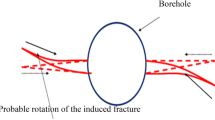Abstract
Conditions of carrying out laboratory investigations are examined, and calculated formulas are presented for determination of rock resistance to hydraulic fracturing.
Similar content being viewed by others
References
S. P. Timoshenko and J. Guder,Theory of Elasticity [in Russian], Nauka, Moscow (1975).
S. J. Klein,Theory of Similitude [Russian translation], Mir, Moscow (1964).
M. A. Biot and D. G. Willis, “The elastic coefficients of the theory of consolidation,”J. Appl. Mech., 594–601 (1957).
B. C. Haimson and C. Fairhurst, “In-situ stress determination at great depth by means of hydraulic fracturing” in: “Rock mechanics theory and practice,”Proceedings of the Eleventh Symposium on Rock Mechanics, Chap. 28. American Institute of Mining Engineers, New York, 559–584, (1970).
B. C. Hamson, “Determination of in-situ stress around underground excavations by means of hydraulic fracturing (final technical report, APRA, Contract No. H0220080)” U.S. Bureau of Mines (1974).
M. V. Kurlenya, A. V. Leontyev, and S. N. Popov, “Development of a hydraulic-fracturing method to investigate the stress state of a rock mass,”Fiz.-Tekh. Probl. Razrab. Polezn. Iskop., No. 1 (1994).
B. S. Haimson, “The hydrofracturing stress measuring method and recent field results,”Int. J. Rock Mech. Min. Sci.,15, No. 4, 167–178 (1978).
A. R. Carslaw and C. J. Jaegar,Conduction of Heat in Solids, Oxford at the Clarendon Press, London (1960).
P. Solberg, D. Lockner, and J. D. Byerlee, “Hydraulic fracturing in granite under geothermal conditions,”Int. J. Rock Mech. Min. Sci.,17, No. 1 25–33 (1980).
T. N. Gowd and F. Rummel, “In-situ stress measurements by hydraulic fracturing, ground mines of Kolar gold fields, India (Indo-German collaboration project. Second and final report,” Ruhr University, Bochum (1983).
J. R. Rice and M. P. Cleary, “Some basic stress diffusion solutions for fluid-saturated elastic porous media with compressible constituents,”Rev. Geophys. Space Phys.,14, No. 2, 227–241 (1976).
A. S. Abou-Sayed, C. E. Brechtel, and R. J. Clifton, “In-situ stress determination by hydrofracturing: a fracture mechanics approach,”J. Geophys. Res.,83, No. B6, 2851–2862 (1978).
Additional information
Institute of Mining, Siberian Branch, Russian Academy of Sciences, Novosibirsk, Russia. Translated from Fiziko-Tekhnicheskie Problemy Razrabotki Poleznykh Iskopaemykh, No. 3, pp. 17–23, May–June, 2000.
Rights and permissions
About this article
Cite this article
Serdyukov, S.V. Estimation of rock resistance to hydraulic fracturing from data of laboratory investigations. J Min Sci 36, 209–214 (2000). https://doi.org/10.1007/BF02562521
Received:
Issue Date:
DOI: https://doi.org/10.1007/BF02562521




